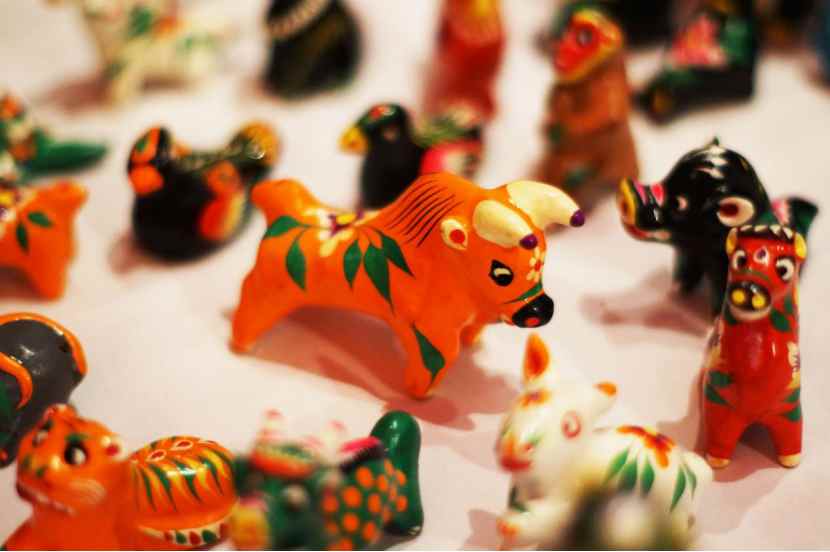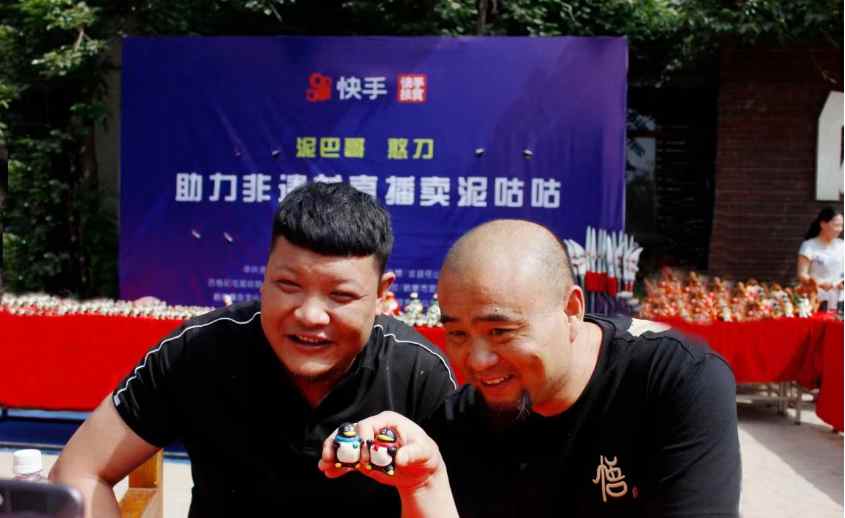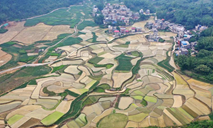Clay sculpture maker in China revitalizes the traditional handcraft via short videos
“Let’s go get some saplings,” said a villager. Then a truck “rumbled” out of a village; villagers carefully selected saplings at a stall; and then the saplings were planted with the help of crane.

A craftsman makes clay sculpture in the shape of Chinese zodiac sign of sheep in Yangqitun village, Xunxian county, central China’s Henan province. (People’s Daily Online/Wang Zirui)
These realistic scenes come from a short video showing country life on Chinese short video-sharing platform Kuaishou. What’s so special about the video, which has been viewed over 700,000 times, is that the people and settings in it are made from mud.
The short video was made by Zhu Fujun, a clay sculpture maker in Sixiatou village, Xunxian county, central China’s Henan province.
Zhu has posted short videos on Kuaishou to tell stories about his hometown with mud figurines, vehicles and houses he made. Known as “Nibage” on Kuaishou, which means “the guy who plays with mud” in Chinese, he has attracted more than three million followers on the platform.
Making clay sculptures, also known as Mud Cuckoos, is a long tradition in Xunxian county as well as national intangible heritage in China. Villagers in the county knead the premixed mud over and over again, paint patterns on it, and then color it, eventually creating lifelike clay sculptures.

Clay sculptures made by craftsmen in Xunxian county, central China’s Henan province. (People’s Daily Online/Li Shengli)
If people blow at the little holes in these clay sculptures, they will make quick notes that sound like the call of cuckoo, which is why the sculptures are called Mud Cuckoo.
As more and more young and middle-aged residents of the village leave their hometown to seek work in other places, the inheritance of Mud Cuckoo making once faced serious challenges.
Fortunately, a short video of clay sculpture made by Zhu unexpectedly drew wide attention to the traditional handcraft and led to its revitalization.
In 2017, a video of clay sculpture made by Zhu received over two million views, which made him pleasantly surprised and ignited his passion for creation. He began to busy himself with scripting his short videos, making clay sculptures and interacting with netizens.
Gradually, more and more people joined him in making the videos. “We learned from online courses how to move the camera and dub the videos and what kind of stories netizens like. As our videos become more popular, many people come to seek advice from us on shooting techniques,” Zhu said.
While the quality of his videos has been continuously raised, Zhu has also improved his craftsmanship for making Mud Cuckoos. “We also learned from Wang Xueren, a provincial-level inheritor of the national intangible heritage,” Zhu said, adding that although clay sculptures are small artworks, they still require plenty of skills.
As his short videos receive increasing “likes”, Mud Cuckoos have also become more widely known.
“During my first livestreaming show for selling clay sculptures, nearly 200 orders were placed and all the products I prepared for that show were sold out within seconds. I never expected clay sculpture to be so popular with netizens,” Zhu recalled.
Zhu has also motivated his fellow villagers to join him in promoting Mud Cuckoos. He introduced the history of the traditional handcraft in his videos and recorded how senior residents in the village make clay sculptures at their homes. “We have helped more than 100 craftsmen sell nearly 100,000 clay sculptures,” Zhu said.
Short videos have revitalized rural culture. “We encourage young people to make high-quality short videos and promote the digitization of excellent rural cultural resources,” said Zhou Xiaohan, vice president of Kuaishou pan-knowledge and paid business.
“Nowadays, videos of intangible cultural heritage are posted on Kuaishou every three seconds, with a cumulative views exceeding 224.5 billion,” Zhou said, adding that more than 190 million monthly follow and learn agricultural knowledge through the platform.
Digital technologies have injected impetus into rural culture and brought folk crafts, customs and other forms of excellent rural traditional culture back to life.
China has called for efforts to pool data resources including rural cultural relics, intangible cultural heritage, regional opera varieties, and agricultural civilization sites to enrich the reserves of Chinese cultural heritage and realize digital preservation of core rural cultural resources.

Zhu Fujun (left), a clay sculpture maker in Sixiatou village, Xunxian county, central China’s Henan province, introduces Mud Cuckoos, clay sculptures made with a traditional local handcraft, to netizens via livestreaming. (Photo/www.hebiw.com)
During the country’s 14th Five-Year Plan (2021-2025) period, the central government of China will continuously support the implementation of projects for the construction of national smart library system and digital construction of public culture to further facilitate digital public culture construction.
With continuous improvement in digital information infrastructure, the increasingly wide application of digital technologies in rural areas will help more traditional handcrafts brim with renewed vitality.
Photos
Related Stories
- Have fun with DIY rubber stamps
- Tibetan handcrafts create jobs
- University sets up handicraft courses in Gansu
- Students experience handicraft of making blue calico in China's Nantong
- Blacksmith couple in N China
- Reviving the lost art of making silk parasols
- Competition showcasing handmade craftwork held in Guiyang
Copyright © 2022 People's Daily Online. All Rights Reserved.










